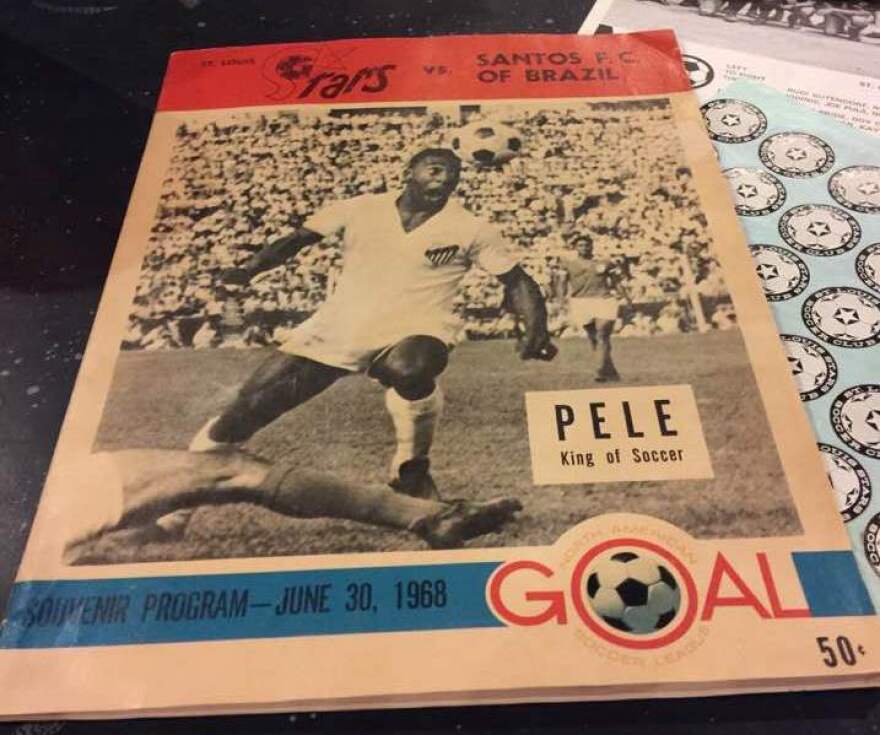The effort by backers of a potential Major League Soccer expansion franchise for St. Louis has some fans reflecting on the history of the sport in the region. That includes memories of a top-level professional team in late 1960s through the mid-1970s called the St. Louis Stars.
The team was part of the old North American Soccer League and featured plenty of area players, such as Pat McBride, who was on the Stars for a decade.
"The soccer purists, so to speak, they came out and there was good support," McBride said in an interview for St. Louis Public Radio.
"As we gravitated toward having more of a nucleus of St. Louis players, I think we gained support."
The NASL had teams scattered throughout the continent, and in an effort to raise the profile of the sport in Canada and the U.S., the flagship New York Cosmos attracted big-name international players, like Pele, who is considered one of the best of all time.
Pele attracted a crowd when he came to St. Louis.
"At that time we were probably averaging maybe 12-to-15,000 a game. When Pele came we had 30,000," McBride recalled.
The 1968 match with Pele was at the old Busch Stadium. The Stars split their home games through the years between that venue and Francis Field at Washington University. The Wash U location provided a better atmosphere because of the size of most crowds. Like many throughout the league, the stadiums were built for other sports and that caused significant problems.
"Those stadiums needed to be modified in some way for soccer," said Jack Galmiche, a former Stars player, and now general manager, president and chief executive officer of the Nine Network of Public Media, the public television service in St. Louis.
Despite the stadium issues, he said the team managed to build a strong connection with hardcore soccer fans, with the help of an outreach program.
"We said 'hey, look. If you need a speaker, if you need a clinic, if you need an athlete to be part of your event, we're very happy to provide that.'"
Galmiche said that approach helped with ticket sales.
"Whenever we would do these things, we would invite these organizations to bring a group down."
https://www.youtube.com/watch?v=BGdTaxypexI
There was also a focus on families.
"Kids could play at half-time and so we would attract parents and grandparents and brothers and sisters," Galmiche said.
"We did all kinds of things to attract interest in the team at that time."
The ticket office might have tried to pull out all the stops to get people in the stands, but for at least a few years the team's on-the-field success helped fill the seats. That includes the 1972 season. The Stars went to the league championship, but lost to New York.
The St. Louis Stars joined the NASL in 1968 and lasted until 1977. That's when an ownership group from California bought the team and moved it to Anaheim. The California Surf was dissolved in 1981. The league lasted until the mid-80s, but eventually ended with many of the remaining teams losing money.

St. Louis-based soccer announcer Bill McDermott goes back decades with the sport. He says one of the key reasons why the current, top-level, pro league, Major League Soccer, is on more solid footing than its predecessor of more than four decades ago is the construction of soccer specific stadiums throughout the U.S.
But that's not the only reason. Essentially, the game has become more attractive as an investment for those with deep pockets.
"They now realize that it is a viable alternative for the sports dollar," McDermott said in an interview.
He also said soccer is not for investors trying to make a quick buck.
"Are they going to make money the first couple of years they are involved in it? Of course not. That’s not going to happen. The outlay of money at the outset is so extraordinary — it takes a while to regain that money, to recoup that.”

McDermott is among those hoping the effort to build the stadium and secure and expansion MLS franchise are successful so the St. Louis region can help regain an unofficial title.
"St. Louis used to be the soccer capital of the United States. It no longer is. I don't know where that is. Is it in Plano, Texas; Pasadena, California — we don't know," McDermott said.
"But one thing that we are abundantly certain of — any degree of acceptance, a new found cache, a respectability, a notoriety that the sport of soccer enjoys in our country today is directly responsible to what St. Louis started well back in 1875."
The stadium financing issue could be sorted out early in 2017, providing a clear indication on whether the city is about to write a new chapter in its rich soccer history that includes the St. Louis Stars.
Follow Wayne on Twitter:@WayneRadio






